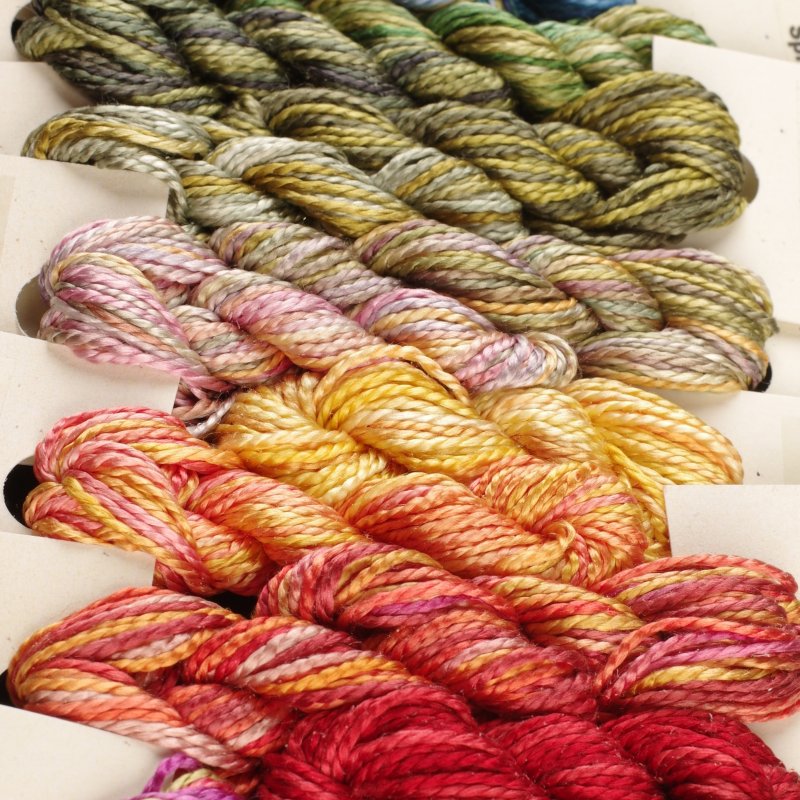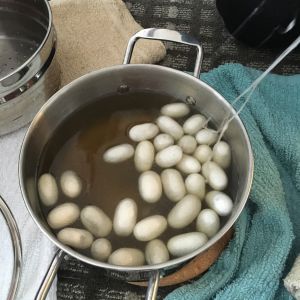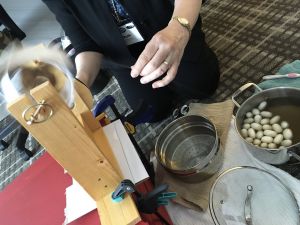
Serenity Silk Thread in Montano colorways
People have a love/hate relationship with Serenity silk thread. People love the look and the gorgeous sheen. But some people hate using it until they learn a few simple tips--then they love it!
Serenity is a reeled silk thread, about the size of a fat #3 perle. It's lovely as an embroidery thread and is also beautiful in needlepoint.
Serenity is suitable for 13-mesh canvas (brick stitch) and for decorative stitches on 18-mesh canvas.
Reeled Silk & Silk Cocoons:
Reeled means it's made of continuous, unbroken filaments "unwound" from the bombyx mori silk cocoon. After eating non-stop for 3 weeks, the silk worm is plump and ready to spin his cocoon [there are male and female silk worms, I just always call them "he"]. The little guy first spins silk to make a "hammock" for his cocoon. Then he spins non-stop for about 72 hours to create his cocoon, working from the outside in. The A1 Quality cocoons can have up to a mile of unbroken, continuous silk filament.
The silk filament is made of two proteins: Fibroin (center), which is coated with Sericin. The sericin hardens when it dries. Sericin protects the fibroin and holds the cocoon's shape.
The "hammock" silk is stripped away from the cocoon when preparing the cocoons for reeling. This is called "silk cocoon strippings".
A single filament is too fine to use, so when reeling, several cocoons (10 is a common number) are soaked in a hot bath. The sericin softens, allowing beginning of each cocoon's filament to float loosely. All of the cocoon ends are captured and held together and then all cocoons are unwound together [photos below]. The sericin dries almost immediately, causing the 10 filaments to become one. This process of "unwinding" the silk from the cocoon is called "reeling".
This silk is still too fine to use, so multiple "joined" filaments are combined to create silk thread.
Reeled silk has the most sheen. The amount of twist impacts the sheen that you see. Serenity is two strands of silk gently twisted together. Each strand is made of multiple (hundreds) of filaments,
Serenity Tips & Tricks:
1) Smooth hands are extremely helpful—use a sugar scrub or other hand exfoliant before handling Serenity. After using an exfoliant, we love our Artisan Unscented Lotion Bar (no lanolin) to keep our hands smooth.
2) Use a needle with a large eye. If you find Serenity is "shredding" as you use it, change to a needle with a larger eye.
--needlepoint canvas, try tapestry 20 or 22 needle
--fabric, try chenille needle size 18 or #1 Gold Eyed Milliners needle
3) Keep your thread length no longer than 18”. Some needlepoint teachers even suggest 12 inch thread lengths. This is really important. The softly twisted Serenity is strong, but can only handle being pulled through a needlepoint canvas or fabric so many times before showing some wear. Shorter thread lengths allow you to use the entire length of your thread.
4) Pull your needle straight up and straight down as much as possible. This is especially important if you're stitching on needlepoint canvas--if you bring up your needle and thread at an angle, you'll unintentionally scrape your silk against the edge of the canvas' hole. Scraping against canvas causes your thread to shred.
Click to see all colors of Serenity: 121 hand-dyed solids, 17 Montano colorways, eight 65 Roses Colorways.



